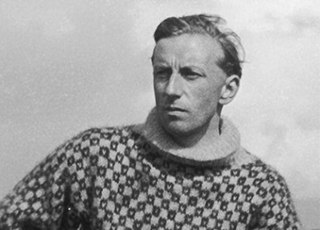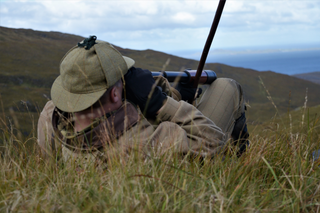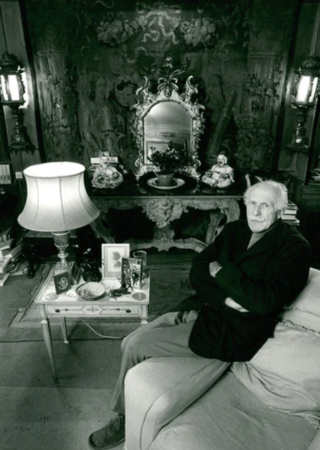
Sir Rupert Charles Hart-Davis was an English publisher and editor. He founded the publishing company Rupert Hart-Davis Ltd. As a biographer, he is remembered for his Hugh Walpole (1952), as an editor, for his Collected Letters of Oscar Wilde (1962), and, as both editor and part-author, for the Lyttelton/Hart-Davis Letters.

Robert Peter Fleming was a British adventurer, journalist, soldier and travel writer. He was the elder brother of Ian Fleming, creator of James Bond, and attained the British military rank of Lieutenant Colonel.

Alastair Arthur Windsor, 2nd Duke of Connaught and Strathearn was a member of the British Royal Family. He was the only child of Prince Arthur of Connaught and Princess Alexandra, 2nd Duchess of Fife. He was a great-grandson of Queen Victoria through his father and a great-great-grandson of Queen Victoria through his mother. He was also a descendant of Victoria's paternal uncle and predecessor, William IV, through an illegitimate line.
Robert Markham is a pseudonym used by author Kingsley Amis to publish Colonel Sun in March 1968. The book was the first continuation James Bond novel following the death of Bond's creator, Ian Fleming.

Gavin MaxwellFRSL FZS FRGS was a British naturalist and author, best known for his non-fiction writing and his work with otters. He became most famous for Ring of Bright Water (1960) and its sequels, which described his experiences raising Iraqi and West African otters on the west coast of Scotland. One of his Iraqi otters was of a previously unknown sub-species which was subsequently named after Maxwell. Ring of Bright Water sold more than a million copies and was made into a film starring Bill Travers and Virginia McKenna in 1969. His other books described sharking in the Hebrides and his travels in Iraq, Morocco, and Algeria, as well as studies of recent history in Sicily and Morocco.

William Ewart Berry, 1st Viscount Camrose, DL was a British peer and newspaper publisher.
Operation Goldeneye was an Allied stay-behind plan during the Second World War to monitor Spain after a possible alliance between Francisco Franco and the Axis powers, and to undertake sabotage operations. The plan was formed by Commander Ian Fleming of the Naval Intelligence Division (NID). No German takeover of Spain took place, nor an invasion of Gibraltar, and the plan was shelved in 1943. Fleming later used the name for his Jamaican home where he wrote the James Bond stories.

Sir Alan Frederick "Tommy" Lascelles, was a British courtier and civil servant who held several positions in the first half of the twentieth century, culminating in his position as Private Secretary to both George VI and Elizabeth II. In 1950, he wrote the Lascelles Principles in a letter to the editor of The Times, using the pen-name "Senex".

James Gomer Berry, 1st Viscount Kemsley, GBE was a Welsh colliery owner and newspaper publisher.
Eileen Alice Soper was an English etcher and illustrator of children's and wildlife books. She produced a series of etchings, mainly of children playing, and illustrated books for other writers, notably for Enid Blyton and Elizabeth Gould. She also wrote and illustrated her own children's book. Some of her illustrations of children and animals were used in a china series for children by Paragon China in the 1930s. Later in life she concentrated on writing and illustrating wildlife books. She was a founder member of the Society of Wildlife Artists (SWLA) and was elected a member of the Royal Society of Miniature Painters, Sculptors and Gravers (RMS) in 1972.

Deer stalking, or simply stalking, is a British term for the stealthy pursuit of deer on foot to hunt for venison, leisure, trophy, or to control their numbers as part of wildlife management, just as with rabbiting and boar hunting. Deer hunted in the UK are red deer, roe deer, fallow deer, sika deer, muntjac, water deer, and hybrids of these deers.
Adrian Michael Berry, 4th Viscount Camrose was a British hereditary peer and journalist

Hesketh Raoul Lejarderay Millais, usually known as Raoul or 'Liony' Millais was a portrait painter, equestrian artist and sportsman.
Captain Alan Hugh Hillgarth (1899–1978) was a British adventure novelist and member of the intelligence services, perhaps best known for his activities in Spain during and after the Spanish Civil War. Hillgarth appears as one of the actual historical figures in C. J. Sansom's 2006 novel, Winter in Madrid, and also in María Dueñas's 2009 novel, El tiempo entre costuras, as well its Spanish-language 2013 television adaptation.
The Literary Society is a London dining club, founded by William Wordsworth and others in 1807. Its members are generally either prominent figures in English literature or eminent people in other fields with a strong interest in literature. No papers are delivered at its meetings. It meets monthly at the Garrick Club. The Daily Telegraph's online site called the club "Britain's most distinguished and discreet literary dining club".

John Guille Millais was a British artist, naturalist, gardener and travel writer who specialised in wildlife and flower portraiture. He travelled extensively around the world in the late Victorian period detailing wildlife often for the first time. He is noted for illustrations that are of a particularly exact nature.

Thomas Alexander Barns FZS FES, known in his private life as Alexander Barns, was an English businessman, explorer, big game hunter, author, artist, naturalist and lecturer connected with the opening up of Central Africa by Europeans in the early 20th century.
A bibliography of reference material associated with the James Bond films, novels and genre.
Take Over is an unpublished 1970 James Bond novel purportedly written by Ian Fleming six years after his death. Spy author Donald McCormick believes this "remarkable story" is perhaps Ian Fleming's strangest legacy. In 1970 a retired bank officer and his daughter who have never been identified claimed to have transcribed works from the "great yonder" by deceased authors. None of the works has ever been published.
The Muckle Hart of Benmore was the name given to a red deer stag that was stalked (hunted) by the 19th-century naturalist and hunter Charles William George St John. In his book Short Sketches of the Wild Sports and Natural History of the Highlands, he described the continuous hunt of the stag for six days and five nights, culminating in its dramatic demise on 1 October 1833. St John's account of the stalk was widely republished, and the deer has been described as "the most famous red stag to be recorded in the annals of British sport".










